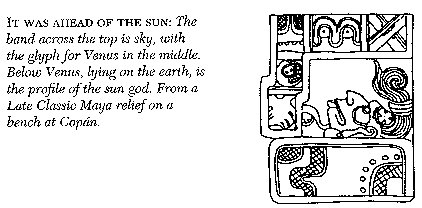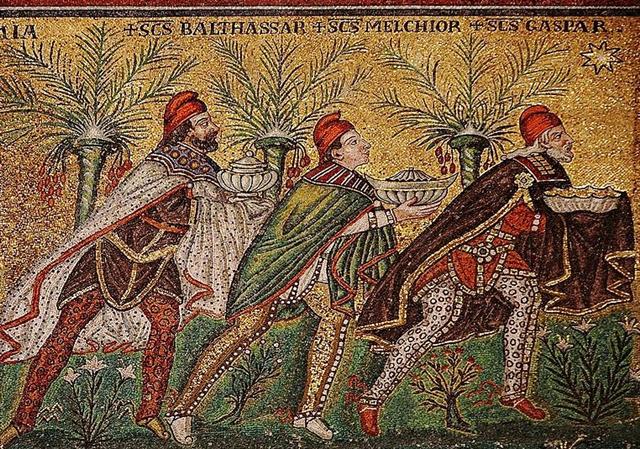3. If we then will shift our attention to the beginning of line a2 it seems reasonable to change the equation of 1 glyph = 1 day into an equation with 2 glyphs = 1 'day and night', and my 8-groups are helpful in visualizing such a pairwise structure:
The planetary colours are here counted from Gb8-30, because I perceived a better fit this way than by counting them from Ga2-1. For instance is Ga2-7 not coloured after Mars. I guess these 16 glyphs might represent 8 months of a lunar character. Glyph line a2 is upside down compared with line a1, and maybe the upside down lines are meant to follow Moon (and the odd numbered lines to keep track of Sun). 236 + 236 / 2 = 354 = 12 * 29½. However, the signs which can be read in the glyphs quickly demolish the simple 8-fold division above and the structure should rather be e.g.:
I have here returned to my model with counting colours from the beginning of the line. The table could describe 3 + 3 + 3 = 9 months. The 8th of them is special, it has no toga but a mago glyph instead. The number of glyphs is 2 + 16 = 18 and I included Ga1-29--30 at the beginning in order to reach a symmetry. However, the glyphs then seem to suggest I should include also Ga1-27--28, because they are drawn with open outlines like Jupiter in Ga1-29, and at bottom in Ga1-26 there is a viri sign (probably indicating a cardinal point), and 472 + 27 = 499 (100 days more than 399, the synodical cycle of Jupiter):
4 + 16 = 20 is better than 18, for instance because in the Hawaiian calendar we probably are meant to add the last 4 nights from the preceding month to the beginning of the current month:
Also, the Gilbertese counted their months as 20 nights. Therefore I will once again rearrange my structure:
By incorporating 4 glyphs instead of 2 from the preceding line I broke my earlier symmetry. But another symmetry is perceived by separating 'sky' from 'earth' and 'sea', and 'sea' will now become like a mirror image of 'earth'. On the other side of the equator (the 'mirror') everything is the same, but upside down:
Mago in Ga2-14 can be imagined as a 'reflection' of vaha toga in Ga2-10. 2 * 10 = 20 and 2 * 14 = 28. If we dare continue to reflect from such an opposition it ought to mean that mago in Ga2-14 is at the opposite 'hole' - it could mark the position when summer is returning. Ga2-14 perhaps represents spring equinox. Mars is the appropriate planet because spring equinox is towards the end of 'March' (September). 10 months seems to be the basic structure, given that we rearrange so that the 'double hook' of Saturn in Ga2-11 is at the beginning of the year:
11 = 10 + 1 etc and the old year stretches up to and including mago, i.e. we have to add 4 months from winter solstice to reach the arrival of summer. In a Moon calendar 4 months is equal to a quarter of the cycle, because 4 / 16 = 25 %. The rest of the Moon calendar will then contain 16 - 10 = 6 months, the first pair of which should be the 'tail months' of the preceding year (with Jupiter appropriately as the last of them):
To find the remaining 4 we have to move on 'into another story' (beyond ordinal number 16 in the line):
The ending has ihe tau and it is a Moonday. In other words, I have 'sky' at the beginning, with 3 odd glyphs ending with the headless Jupiter in Ga1-29 (tagata rima aueue):
3 kinds of copal were offered in the direction of the rising sun (but no such thing by Black Jaguar). 3 were also assumed to be the number of the wise men of the east:
And 3 days under the arm of Old-Spider were necessary to induce her power: ... By repeating a charm, she opened the two shells and slipped inside. She could see nothing, because the sun and the moon did not then exist; and then, she could not stand up because there was not enough room in the shellfish. Constantly hunting about she at last found a snail. To endow it with power she placed it under her arm, lay down and slept for three days. Then she let it free, and still hunting about she found another snail bigger than the first one, and treated it in the same way ... I guess the 'power' could be expressed by the sign at right in Ga1-28. 3 days of sleep will result in 5 (power, fire, etc), an idea which I find confirmed by Rei at Venus (Ga1-30), a glyph type which significantly begins with a capital (head) letter:
The creation has 5 ('fire fingers') in the sky at the beginning. Then comes the 'sea', the season when Sun not yet has reached down to earth:
With *514 I mean 472 + 31 + 11, the ordinal number if we continue counting on beyond the end of side b. The reversed shark (a creature of the sea) could signify the end of 'sea'. We can think of Ga2-14 as related to the 'sun carrier' (possibly Ga2-15): ... And here is the dawning and showing of the sun, moon, and stars. And Jaguar Quitze, Jaguar Night, Not Right Now, and Dark Jaguar were overjoyed when they saw the sun carrier. It came up first. It looked brilliant when it came up, since it was ahead of the sun ... 6 glyphs are enough (I guess) to cover summer, the season when Sun (and possibly also his mirror image) are present:
... And then the face of the earth was dried out by the sun. The sun was like a person when he revealed himself. His face was hot, so he dried out the face of the earth. Before the sun came up it was soggy, and the face of the earth was muddy before the sun came up. And when the sun had risen just a short distance he was like a person, and his heat was unbearable. Since he revealed himself only when he was born, it is only his reflection that now remains. As they put it in the ancient text, 'The visible sun is not the real one ... ' Beyond vaha toga (Ga2-10) the beginning of next cycle could come:
The curious 'wing' at left in Ga2-15 could represent something carried on the back. 4 + 6 + 3 =13 glyphs remain to the end of the line:
|


















